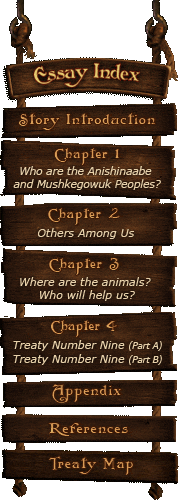
We, the Anishinaabe and Mushkegowuk Peoples, are often referred to as Sub-arctic hunting and gathering peoples, meaning that we live and hunt in a region that is south of the Arctic Circle in Canada. You can think of us this way too but as you shall see, we too have our own words to describe where we live.
Many people that have studied us for many years also refer to us as the "original" or "First" peoples. They know that we consider ourselves to be the first peoples to have inhabited the place known as North America. We like these terms for we know in our hearts and minds that our special way of living in the north existed long before non-indigenous people ever knew about us or entered into our lands. In this way we believe ourselves to be first. However, we also believe that we were second to the animals. You see our ancient stories tell us that the animals, fish, and birds existed on earth first before we did as humans. You will understand what I mean when you read our Creation story.
First though, what do our names refer to? Well, the Anishinaabe people within the Nishnawbe Aski Nation are also known as the Ojibway, Ojibwa or Northern Ojibway. Some people translate these terms to mean the people with "puckered seams" in describing the Anishinaabe style of moccasins. However, today, as in the past, the word Anishinaabe simply refers to the people of the land. Likewise, the Muskegowuk Peoples, my people, are referred to today as Cree, Swampy Cree or Lowland Cree. To us, Mushkegowuk, means people of the muskeg or people who live in the muskeg.
Today, as in the past for thousands of years, we, the Anishinaabe and Mushkegowuk Peoples, share the same understanding in describing ourselves. The words we use to describe ourselves show that we consider ourselves to be part of the land. Nishnawbe means people and Aski means land. So, we are literally the Nishnawbe Aski Nation - the people of the land. We love our land and have a special, sacred attachment to it and we believe that we must care for it as it has cared for us.
As I’ve said, over many centuries of living within our lands, both our peoples (Anishinaabe and Mushkegowuk) knew the land and what it gave us. As well, we have never forgotten our forefathers who used and cared for the land. We know our ancestors lived, died and are buried in many places in the land.
In terms of food, our ancestors lived well by sharing the animals, fish, birds that also inhabit the land, rivers and waters in our vast territory.
Both our peoples were and still are hunters, trappers and fishermen who learned special hunting knowledge that has been passed down over many centuries. This knowledge is experiential, tested by trial and error, and refined over hundreds of years. We needed time to understand the specific behaviors of many types of wildlife so that we could become experts in harvesting them. Some of the wildlife we live on includes rabbit, fox, marten, beaver, moose, caribou, pike, whitefish, trout, pickeral, geese, duck, and partridges. Like our ancestors, who viewed the animals, fish, birds, rivers, lakes and land as inter-connected, so we too today believe that we are only one small part in the greater world of land and animals. Just like the animals, fish and birds need air, sky, rain, rivers, lakes to survive, we also are dependent on them for our survival. In this way, we developed our philosophies from the land and animals; we lived by ideas of trust, reciprocity and sharing of the land and resources.
Furthermore, we developed an intimate understanding, over time, of the delicate balance, interaction and interdependency of the environment, wildlife and humans within the food chain. Our specialized, hunting skills helped us to observe, adapt, understand and predict the timeless cycles of wildlife in relation to the recurring seasons (summer, spring, fall, winter), climates, and temperatures that affected all life forms and our lives as well. It took us many thousands of years to develop and accumulate all our knowledge, to respect and use it in living well.
The land was always shared with animals, and our Ancestors understood their movements very well… Our people knew where the caribou would winter and where they would stop. It’s the same thing with migrating birds. Our people had a special place for them to eat. They understood the kind of land they needed, and that the birds would give us a food supply… All the hunters and young hunters-to-be were told where to hunt, and where not to hunt. The birds knew where they had a priority, and where they could eat properly and be healthy. Only when the right season arrived did the people hunt them… (Elder Louis Bird, Peawanuck in Macdonald, Arragutainaq, Novalinga 1997: 6).
